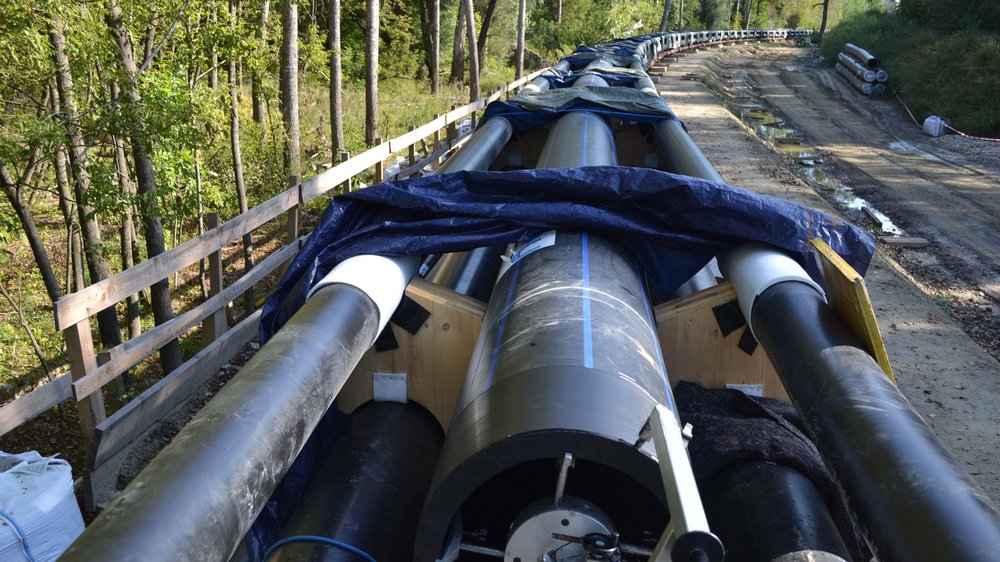In order to connect the gas, water and district heating pipelines of the two municipalities, EVN had built a 460-metre-long micro-tunnel with a cross-section of two metres beneath the Danube. The tunnel, which was constructed by pipe jacking, contains the Korneuburg-Klosterneuburg high-pressure natural gas branch line made of steel as well as two AGRULINE drinking water pipes made of the high-performance plastic PE 100-RC in the dimensions OD 560 mm SDR 11 for max. 16 bar operating pressure. AGRU Kunststofftechnik GmbH supplied a total of more than 1,000 m of PE 100-RC piping including fittings. For precautionary reasons, two district heating pipes and a reserve high-pressure gas pipe made of steel as well as 16 cable protection pipes made of plastic for electricity and optical fibres were installed in the Danube culvert. AGRU Kunststofftechnik GmbH supplied a total of 2,880 m of PE 100-RC pipes and fittings in OD 160 mm SDR 21 for the cable protection pipes.
Trenchless pipeline construction for infrastructure
The 460 m long Danube culvert begins on the Klosterneuburg side and ends on the Korneuburg side. It was bored using the pipe jacking method by a 40-tonne drill head and lined with concrete pipes. The tunnel route is not straight, but runs in a radius of 1,600 metres. This "banana shape" results in different cover heights up to the Danube bed of approx. 5 m in the bank area and max. 11 m in the middle of the Danube. Thanks to the trenchless construction method, the Danube could be safely crossed underneath and the concrete pipe with an internal diameter of 2 m could be laid efficiently. The pipes for drinking water, natural heat and internet were welded, brought into position on a carriage construction and pulled into the tunnel tube via a rail system. AGRU supplied 18 m extra-long PE 100-RC pipe rods in OD560 mm, which considerably reduced the welding effort. Mechanically manufactured heating coil sleeves were used in the connection areas. The tunnel was then sealed at both ends, filled with water and the pipes examined for possible defects. "After a positive conclusion of the examination, the tunnel was filled with a concrete suspension and sealed permanently and maintenance-free," explains EVN company spokesperson Stefan Zach.
District heating and drinking water networked
On the Korneuburg side, pipelines were laid from the EVN power plant site and from a well field to just before the bank of the Danube, and the necessary tunnel work was carried out under the railway line and the A22. An EVN biomass heating plant supplemented the Korneuburg thermal power plant in 2015. It converts forest chips from the region into sustainably produced and environmentally friendly heat. This is also another reason for the construction of the supply tunnel. EVN spokesperson Stefan Zach: "The biomass plants on both sides of the Danube can stand in for the other plant at any time in the event of a breakdown or revision. Since we also have large well fields and springs on both sides of the Danube, the tunnel enables the drinking water reserves to be interconnected. This can be of essential importance in the event of a well field failure. Especially in challenging times like these, it shows how important regional supply security is."



![EVN invested around 10 million euros in the tunnelling of the Danube and the implementation of the pipelines for drinking water, natural heat, internet, electricity and gas. [Source: EVN] EVN invested around 10 million euros in the tunnelling of the Danube and the implementation of the pipelines for drinking water, natural heat, internet, electricity and gas. [Source: EVN]](/fileadmin/_processed_/e/3/csm_RS23746_DJI_0939_kl_a06a37fe6e.jpg)